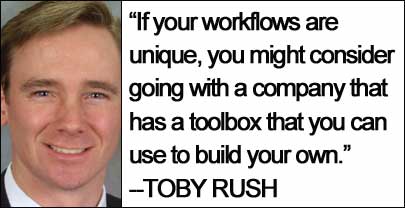Jun 01, 2006Companies deploying RFID—in particular, Electronic Product Code technologies—in the open supply chain can spend months testing the latest RFID tags and interrogators, configuring hardware to improve read rates or discovering the best tag placement for RF-unfriendly products or assets. But until they can manage the encoding and reading of those tags, put the data into context and tap into the greater visibility and efficiencies an RFID system can offer, the physical layer of the RFID deployment is of no real value.
Enter RFID middleware—a software platform that resides between your RFID interrogators and your enterprise software. Middleware is essential if you want to expand a small pilot project to a larger, integrated system that can provide internal benefits, not just mandate compliance. That's because middleware can control and configure a network of tag-reading devices; collect and filter the data; link the data with application software, such as warehouse, order and transportation management systems; and process the data using business rules, so you can improve your operations. Some middleware products also can link RFID data with data collected from various types of bar codes, sensors and other data collection devices.

Ready to sign up? There are plenty of companies that would like to sell you middleware. A few years ago, there was only a handful of pioneering companies offering middleware platforms designed specifically for RFID systems. Today, the number has mushroomed, with middleware offerings from the smallest IT shops to the largest enterprise software providers. But not all middleware products—or middleware providers—are alike. Here's what you need to know to make a smart decision.
Key Functions
First, let's take a more detailed look at the many different functions RFID middleware can perform. Few, if any, products will do all of these, but once you focus on the key functions you need, you can narrow down your middleware options.
Manage devices.
Some types of middleware control all of the hardware—interrogators, printer-encoders and input/output devices, such as light trees or motion sensors linked to the interrogators—needed in an RFID system. They can monitor the health of an interrogator and alert administrators when one malfunctions. If that happens, middleware might automatically activate a backup interrogator device, so that the system doesn't suffer any downtime. Middleware also manages upgrades to the network or devices it supports.
Process data.
As tag data is collected, it must be filtered so that duplicate reads aren't passed along to back-end systems. This function becomes increasingly important as the size and complexity of RFID systems grow.
To facilitate the tag filtering, aggregating and flagging, EPCglobal, the nonprofit organization set up to commercialize EPC technologies, created middleware interface specification standards called application-level events (ALEs). Many middleware providers are now using the ALE standard to help decrease the amount of unwanted data that middleware pulls from the interrogators or sends to back-end applications.
Link data with back-end systems.
Middleware typically has a toolset, including a library of application program interfaces (APIs), that companies can use to bridge the RFID tag data they collect with their application or enterprise software systems. For example, an enterprise resource planning (ERP) platform can be configured to flag orders being shipped to RFID-enabled distribution centers or stores. When the warehouse management system (WMS) receives the flagged orders, it passes them through an API to the middleware, which can generate an EPC for each pallet or case in the order, associate the EPCs with the order information and then create an RFID smart label print command for a printer-encoder. The middleware can also send this order and EPC data to the ERP, which can pull the EPCs into an advance shipment notice (ASN) for the receiver or use the EPC data to analyze sales feedback from a retailer.
Middleware is also responsible for pulling data from enterprise databases and generating an EPC to be encoded to each tag. It then sends commands to label printer-encoders or interrogators mounted on a conveyor to encode the EPC to the appropriate tag.
Some middleware platforms now offer an interface to link with EPC Information Services (EPC IS), a Web services integration database that acts as an online resource for storing data associated with EPCs and enables companies to exchange EPC-related data with trading partners. At the local level, the EPC IS also provides architecture for the business intelligence used to direct workflows. EPCglobal is close to ratifying a standard EPC IS, which is used by most middleware platforms that include the service.
Some companies sell only RFID middleware. These "pure-play" providers, such as Avicon, GlobeRanger, OATSystems and Shipcom Wireless, focus on the device management and data aggregation functions of middleware. Most also offer integration links to pass the appropriate RFID tag data from the middleware to application software systems. Some pure-play vendors are beginning to offer applications of their own, such as using RFID data from retailers to manage product promotions or pulling EPC codes into ASNs. Over the past couple of years, pure-play middleware providers have garnered a deep well of RFID deployment experience that you can leverage.
Supply-chain application software providers, such as Manhattan Associates and RedPrairie, also sell RFID middleware, either through partnerships with RFID middleware vendors or by offering their own middleware product. If you're planning to deploy or upgrade an RFID-enabled WMS, using the WMS vendor's middleware product or that of its partner might be the best course of action because you won't be faced with developing custom interfaces between the middleware and WMS platform. Also, it could reduce the number of vendors needed for the project.
Large companies that specialize in enterprise infrastructure software, such as IBM, Oracle, SAP and Sun, also provide RFID middleware. They focus on linking RFID data to the other software products they sell. IBM and Sun's middleware platforms include device management and data aggregation, but some providers, such as SAP, tend to partner with pure-play providers for these tasks. For example, early RFID adopter Kimberly-Clark uses middleware from OATSystems for device management and data aggregation; it sends the appropriate data to SAP's middleware, which integrates it into K-C's SAP enterprise applications.
Some large enterprise software companies have bought small RFID middleware specialists, to integrate RFID device and data management services into their own platform. BEA Systems, an enterprise infrastructure software company, purchased ConnecTerra, one of the oldest and largest RFID pure-play middleware providers. And NCR recently purchased pure-play company IDVelocity.
Integration specialists, including Stratum Global and Xterprise, have developed their own middleware. It makes the most sense to use these platforms if you're also using the integration services of the provider, since they are the only ones that can support the products.
To evaluate the different middleware offerings and narrow down your search for a provider, you need clearly defined goals and expectations. Gary Deets, applications manager of global IT for Lego Systems, says devising an early vision was vital to the success of Lego's RFID deployment. "We went into [our RFID] project with a vision, up front, about how we wanted it to work," says Deets. "Vendors will tell you, 'My solution does everything,' but that doesn't mean it's necessarily the right thing for you. If you don't go into something like this with a vision about what you truly want to do, you're selling yourself short."
Do you just want to comply with a tagging mandate?
Some pure-play providers, such as epcSolutions, specialize in getting your RFID system up and running quickly. The middleware has a setup wizard to help you comply with a tagging mandate from Wal-Mart, Target or both retailers. Some companies offer a setup wizard for compliance with the U.S. Department of Defense (DOD) mandate.
SkandSoft Technologies, a pure-play provider, offers plug-and-play software for regulatory compliance, such as using asset-tracking tags to manage safety and capital equipment accountability compliance under the Sarbanes-Oxley Act. It also has setup wizards for applications in logistics, transportation management, airline baggage tracking and point-of-sale systems.
If you're looking for an out-of-the-box solution, these platforms will work. But plug-and-play products aren't designed for integrating data with application software systems. Plus, some of these platforms offer support for only a specific manufacturer's RFID hardware, such as printer-encoders and interrogators, so ask about this if you've already selected hardware partners.
Do you want room to grow?
If, for now, you just want to comply with a mandate but plan to grow your RFID tagging system into an integrated part of your operations, consider both short-term and long-term goals. Some providers, including Avicon, iAnywhere, BEA Systems, GlobeRanger, OATSystems and Shipcom Wireless, provide quick-start compliance solutions that are built on platforms that support growth. OATSystems, for example, sells OATExpress to get companies up and running. Later, its customers can add applications to do things such as collect retailer data on tag reads or receive electronic proof of delivery.
As you plan for the future, consider whether you need to integrate your RFID data with a specific enterprise platform. If so, be sure to ask prospective middleware vendors what type of integration experience they have with it.
You'll also need as much hardware and application integration support as possible to grow the deployment, says Toby Rush, president of Rush Tracking Systems. A middleware provider might support interrogators from manufacturers X, Y and Z, he says, but that "support" might not include all of the interrogators' settings. For example, a middleware product might be able to interface with and send commands to a given interrogator, but it might not include tools to fine-tune its settings to filter tag reads or tune an antenna.
Think about whether you might need support for handheld devices, as well as support for newer interrogator form factors, such as those mounted on forklifts. Sun, for example, offers a lightweight version of its middleware platform that can be embedded in a handheld or other compact, mobile interrogator. Shipcom Wireless has deployed its middleware on handhelds for a number of its clients. Make sure any prospective middleware provider understands what kind of interrogator support you're likely to need.
For Lego, finding a middleware product that could accommodate its order-picking workflow was essential, because it wanted minimal change to its existing business processes. Most middleware platforms include preconfigured workflows for processes such as shipping and receiving. But if you're using RFID for asset tracking or product authentication, or if you employ highly customized workflows, look for a middleware that offers workflow configurability. "If your workflows are unique," says Rush, "you might consider going with a company like BEA Systems that has a toolbox that you can use to build your own." GlobeRanger also provides tools to build custom workflows.
How much scalability do you need?
"Our clients tell us they are looking for IT scalability and also worldwide resource scalability," says Ann Breidenbach, director of IBM's Sensor & Actuator Solutions product-line management and strategy. You might not need a huge firm with a global presence if you want to someday expand your tagging system from your distribution center in Hoboken to your manufacturing plant in Los Angeles. But you will need to support staff in both locations, and you might want the ability to manage both deployments from a single server. You might also want to grow your RFID application to include active tags that track assets, such as reusable totes or pallets. Scalability means flexibility, not only in terms of product or asset tracking, but in finding ways that you can use RFID to address your specific business needs.
"The initial focus [of RFID deployments] was just getting the data," says Breidenbach. "But now we're going to see more focus on applying analytics to the data, and less focus on the physical aspects of reading the tags."
Are you a match?
Choosing the right middleware partner is more than just a matter of matching abilities and product offerings with your needs. Find out how much experience and expertise the vendor has in your industry. What's the middleware provider's long-term viability? A consultant from an RFID-specific practice might offer the industry expertise and strategic guidance that you lack in-house.
Also, consider whether the vendor will be easy to work with—you'll likely be spending a lot of time together. Rush suggests talking to a provider's customers to gather their impressions of the vendor. Ask if they experienced any bumps during deployment and, if so, how the vendor dealt with them. Also ask for the project leads and see if they are still working for the same vendor. Taking the time to evaluate your needs, the middleware and the provider will go a long way toward ensuring the success of your RFID deployment.


